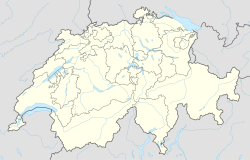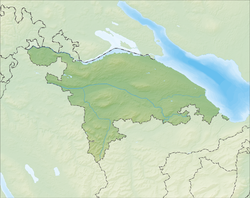Sirnach
| Sirnach | ||
|---|---|---|

Sirnach village
|
||
|
||
| Coordinates: 47°28′N 9°0′E / 47.467°N 9.000°ECoordinates: 47°28′N 9°0′E / 47.467°N 9.000°E | ||
| Country | Switzerland | |
| Canton | Thurgau | |
| District | Münchwilen | |
| Area | ||
| • Total | 12.41 km2 (4.79 sq mi) | |
| Elevation | 545 m (1,788 ft) | |
| Population (Dec 2015) | ||
| • Total | 7,675 | |
| • Density | 620/km2 (1,600/sq mi) | |
| Postal code | 8370 | |
| SFOS number | 4761 | |
| Surrounded by | Eschlikon, Fischingen, Kirchberg (SG), Münchwilen, Wil (SG), Wilen | |
| Twin towns | Helvécia (Hungary) | |
| Website |
www SFSO statistics |
|
Sirnach is a municipality in the district of Münchwilen in the canton of Thurgau in Switzerland.
Sirnach has an area, as of 2009[update], of 12.41 square kilometers (4.79 sq mi). Of this area, 6.69 km2 (2.58 sq mi) or 53.9% is used for agricultural purposes, while 3.09 km2 (1.19 sq mi) or 24.9% is forested. Of the rest of the land, 2.37 km2 (0.92 sq mi) or 19.1% is settled (buildings or roads), 0.09 km2 (22 acres) or 0.7% is either rivers or lakes and 0.2 km2 (0.077 sq mi) or 1.6% is unproductive land.
Of the built up area, industrial buildings made up 9.4% of the total area while housing and buildings made up 0.8% and transportation infrastructure made up 0.5%. while parks, green belts and sports fields made up 7.5%. Out of the forested land, 22.8% of the total land area is heavily forested and 2.1% is covered with orchards or small clusters of trees. Of the agricultural land, 50.1% is used for growing crops, while 3.8% is used for orchards or vine crops. Of the water in the municipality, 0.6% is in lakes and 0.2% is in rivers and streams.
In 1997 Horben, Sirnach and Wiezikon merged with Sirnach.
Sirnach has a population (as of December 2015[update]) of 7,675 As of 2008[update], 21.0% of the population are foreign nationals. Over the last 10 years (1997–2007) the population has changed at a rate of 8.3%. Most of the population (as of 2000[update]) speaks German(85.5%), with Italian being second most common ( 4.7%) and Albanian being third ( 3.0%).
As of 2008[update], the gender distribution of the population was 50.1% male and 49.9% female. The population was made up of 2,643 Swiss men (38.7% of the population), and 778 (11.4%) non-Swiss men. There were 2,747 Swiss women (40.2%), and 659 (9.7%) non-Swiss women.
...
Wikipedia




